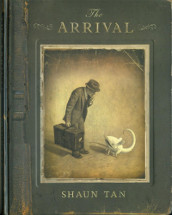The arrival by Shaun Tan

Hachette, 2014. ISBN 9780734415868
(Age: All) Highly recommended. Immigration, Refugees, Loneliness. A
stranger arrives in a strange land, leaving behind his wife and
daughter until he can send for them. He is one of many, moving like
robots through the immigration centre, finding work which casts him
in the same anonymous role. Tan shows clearly through this wordless
book, the disorientation of the new arrival, his efforts to fit in,
to assimilate, his search for work and lodgings. Each page shows a
strange language, impelling the readers to empathise with the
migrant, lost in an unknown and unfriendly city.
Tan's sepia drawings, looking like old photographs, encapsulate the
isolation of the new arrival. Repeated images of dislocation,
disorientation, loneliness and sorrow are found throughout the book,
the end papers having all of humanity shown in passport like
pictures staring at the reader.
The story is divided into six chapters, the first following the man
leaving, packing his suitcase while his wife and daughter accompany
him to the ship which will take him away. He is then found amongst
many others making that journey, sending letters like birds home to
their families. Next he is seen talking to others who have their own
stories of dislocation, sharing their experiences. The fourth shows
the work he is able to get, and his mind drifts into the reasons he
left, while the last chapter shows a positive future for the family
as those left behind prepare to follow. In between we see snippets
of those he befriends, people who share his experiences and help him
along his journey, with the darker tones of some illustrations
reflect the trauma of some of their stories. The image early in the
book of the man seeing his family in his suitcase is haunting (one
amongst many). Tan reprises some iconic images of migration, and the
use he makes of the unusual animal and the engineering works all add
another level of thought and discussion. There are images to share,
images to ponder, and above all to read and reread, gaining more
from each viewing. A New Arrivals class at Richmond Primary School
pondered over this book for weeks, taking it home, sharing it with
their parents and other members of their class. They spoke of it
with recognition: some children were from refugee camps, some from
detention centres, while some had arrived by plane. But they all had
one thing in common, being a new arrival in an alien land, and that
Shaun Tan has shown with incredible dexterity. This group of young
people all found themselves and their families in the faces in the
endpapers, their reasons for leaving their own country in some of
the stories shown. In a classroom, this book could be used as an
introduction to the theme of immigration, of difference, of starting
again, of refugees, of the nature of picture books, or looking at an
illustrator's skill.
This book won accolades around the world when first published: CBCA
Picture book of the year in 2007, NSW Premier's Award, 2007, WA
Premier's Prize, 2007, ABBA award 2007, Best Album Award, France,
2007.
To see it republished in a smaller, softcover edition reminds us
again of Tan's prodigious talents, and the need for books such as
these to be placed in front of readers of all ages.
When asked if this was about the refugee debate in today's
Australia, he responded,
'If The Arrival contributes to a public discussion at all,
it would be in reminding us that these issues are more than just
passing fodder for politicians and media.'
This book soars as it reflects all of our beginnings.
Fran Knight